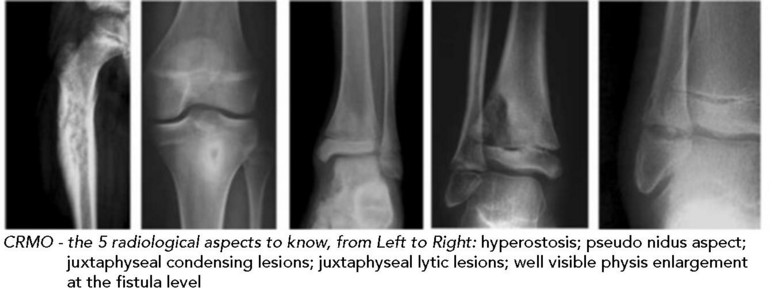(chronic non-bacterial osteomyelitis)
Estimated prevalence between 1/160,000 and 1/2,000,000 and annual incidence between 1/250,000 and 1/1,000,000. Chronic auto-inflammatory syndrome characterized by the presence of multiple foci of painful swelling of the bones, mainly in the metaphyses of the long bones, as well as in the pelvis, scapular belt and spine. An infectious origin is excluded by examinations and a genetic immune dysregulation is suspected in the IL-10 and IL-1 signaling pathways (see DIRA or SAPHO syndromes).
The disease occurs mainly in children and adolescents, and the average age of onset of the disease is 10 years of age. It is characterized by insidious and recurrent episodes of localized pain, sensitivity to palpation or swelling in areas of inflammation of the bones. Systemic signs (fever and weight loss) are common and the disease may be accompanied by inflammatory skin disorders such as psoriasis, palmoplantar pustulosis, acnea, pyoderma gangrenosum and more rarely Sweet syndrome. Chronic inflammatory bowel diseases may also be present such as Crohn's disease or ulcerative colitis.
Diagnosis: imagery shows signs of bone edema, usually followed by osteolytic or sclerotic bone lesions, then hyperostosic lesions, as well as a periostal and soft tissues reactions. Biopsies of the bone lesions are usually sterile, and show non-specific inflammatory changes, as do blood analyses.

Treatment: NSAIDs are the first-line treatment. Oral steroids, azithromycin, bisphosphonates and TNFα inhibitors can be used in cases of inadequate response to NSAIDs, or during periods of exacerbation of the symptomatology.
Anesthetic implications:
antibioprophylaxis, drug interactions with the treatment (corticoids)
References :
- Coinde E, David L, Cottalorda J, Allard D et al.
Ostéomyélite récurrente multifocale chronique de l’enfant : à propos de 17 cas.
Arch Pédiatr 2001 ; 8 :577-83.
Updated: February 2021